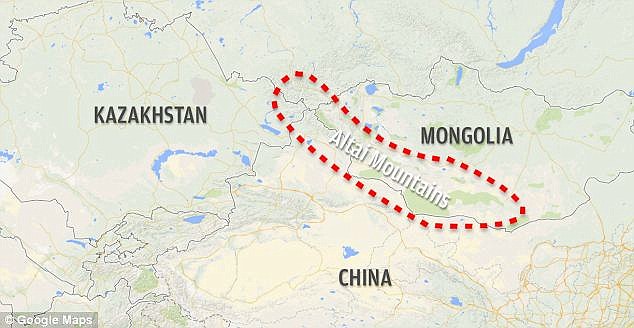Altai Mountains
THE ALTAI MOUNTAINS are a system of remote mountains in central Asia that cover an area of 326,256 square mi (845,000 square km) bounding RUSSIA, KAZAKHSTAN, MONGOLIA, and CHINA. This system is a natural marvel that has been largely untouched by large industries and has a very sparse population. Its name is derived from the Mongolian word altan, which means “golden.” This region is home to many species of wildlife and plants and is made up of various landscapes. Most of the population in this region relies on farming and tourism.
The mountains stretch for 1,242 mi (2,000 km) from northwest to southeast, reaching a height of about 14,783 ft (4,506 m) at Belukha. Many rivers can be found in the Altai Mountains and most of them are fed by glaciers. Some of the largest rivers are Katun, Biya, and Chuya.

The glaciers cover an area of about 900 square mi (2,330 square km). Together with intensive river erosions, they have contributed significantly to the creation of the ruggedness of the region, where high waterfalls, steppes, and thousands of lakes can also be found. The deepest lake in the Altai Mountains, Teletskoe, is 1,066 ft (325 m) deep. The Altai Mountains are the source of the Ob and Irtysh Rivers, two of the major rivers in Asia. The region is rich in many natural resources like iron, gold, mercury, manganese, and marble. The United Nations Educational, Scientific and Cultural Organization (UNESCO) recognized the importance in preserving this eco-region and added five clusters of the Altai in the World Natural Heritage List.
The region is characterized by a continental climate with long, cold winters and short, cool summers. Snow starts covering the mountains during October and November, marking the beginning of winter. Temperatures hit the lowest in January, where they can range from 7 degrees F (-14 degrees C) in the foothills to -76 degrees F (-60 degrees C) in the STEPPEs. In northern Siberia, one can find vast areas of permanently frozen soil. Summers begin somewhere between May and July and end in September. During this time temperatures often reach 75 degrees F (24 degrees C) during the day. Temperatures of 104 degrees F (40 degrees C) have also been recorded in the lower regions. At night, temperatures get cooler, usually ranging from 41 degrees F (5 degrees C) to 50 degrees F (10 degrees C). Elevations of 5,000 to 65,000 ft (1,500 to 19,000 m) experience high precipitation, usually ranging from 20 in (50 cm) to 40 in (1 m) a year. One aspect of the summer that many people appreciate is the lack of mosquitoes.
Four vegetation zones can be found in the Altai Mountains: the mountain subdesert, steppe, forest, and the Alpine areas. The most widely used plants and trees are cedar, badan, kuril tea, and cannabis. The subdesert has very little plant life; the few plants that exist are drought-resistant and salt-tolerant. Many sod grasses and shrubs can be found in the steppe. The forest is generally swampy and covers a large area in the low to medium mountain area. Here are found pines, firs, larches, and birch and aspen forests. The meadows in the Alpine region are used for pasture during the summer.
Wildlife is abundant in this region. There are 230 species of small birds, like woodpeckers, and 20 species of fish. Big mammals like bears, lynx, and musk deer are found mostly in the forest. In the Alpine region live reindeer, mountain goats, rams, and even rare animals like snow leopards. Some areas in the mountains are inaccessible to locals and visitors because they are used to study rare species of animals and plants.
The Altai Mountains are populated by mostly Altais and Russian settlers, many of whom moved there in the 19th century, mainly to escape religious persecution. The native population that was there before the 19th century continues to live in the old ways and is somewhat isolated from civilization. This area faces many challenges, especially with civilization knocking on its door. The big question is how to preserve the ecosystem and its natural beauty in spite of the increasing number of tourists and developments.